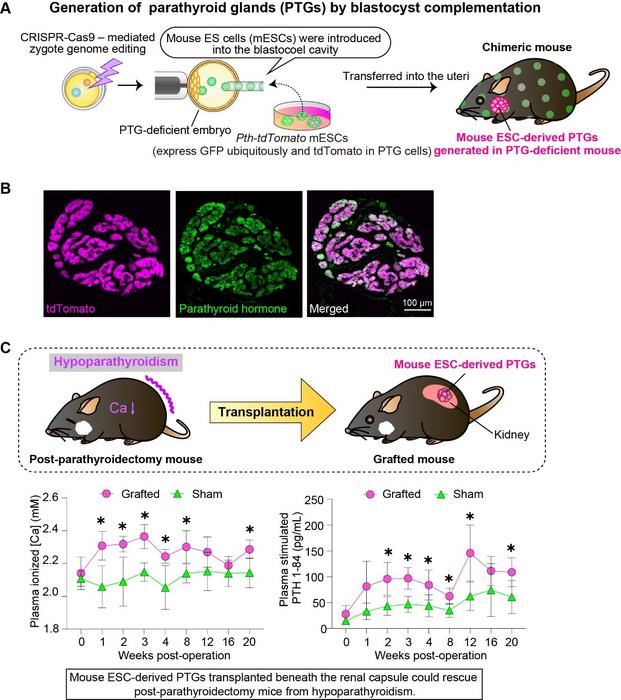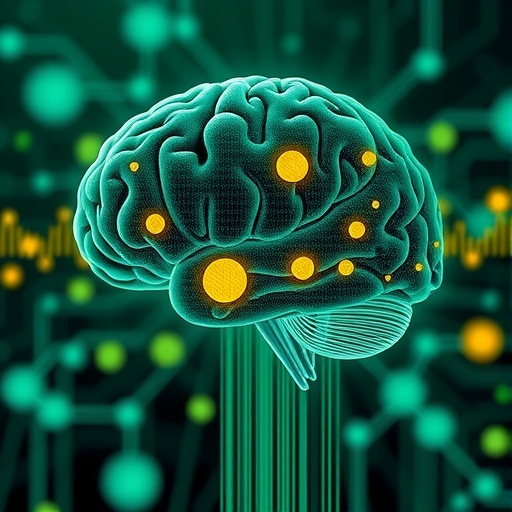Researchers from Tokyo Medical and Dental University (TMDU) show that it is possible to generate functional parathyroid glands using mouse embryonic stem cells using blastocyst complementation

Credit: Stem Cell Therapy Laboratory, TMDU
Researchers from Tokyo Medical and Dental University (TMDU) show that it is possible to generate functional parathyroid glands using mouse embryonic stem cells using blastocyst complementation
Tokyo, Japan – Regenerative medicine has opened up exciting possibilities in the world of medicine. Now, researchers in Japan are searching for ways to recreate and rebuild body tissues and organs, which may be an alternative cure for diseases.
In a recently published study in Proceedings of the National Academy of Sciences (PNAS), researchers from Tokyo Medical and Dental University (TMDU) showed that functional parathyroid glands can be generated from mouse embryonic stem cells (mESCs).
Hypoparathyroidism occurs when the parathyroid glands (PTGs) do not produce enough parathyroid hormone (PTH). PTGs are small endocrine glands that regulate and maintain calcium balance in the body. Properly functioning PTGs express calcium-sensing receptors that respond to changes in calcium and modulates PTH secretion. The causes of hypoparathyroidism can be congenital or acquired, in which the most common cause of hypoparathyroidism is neck surgery. The treatment of hypoparathyroidism requires lifelong replacement therapy. Conventional management includes calcium supplements and Vitamin D analogs as well as full-length recombinant human PTH. However, therapeutic benefits are sometimes limited. If functional PTGs can be regenerated and transplanted, it could provide a new treatment option to overcome the limitations of conventional therapy.
Although the ultimate goal is clinical application in humans, the researchers attempted experiments in mice as a first step. Today, it is difficult to create functional PTG cells that respond to changes in calcium concentration in vitro. For this reason, researchers have attempted to generate functional PTGs using a process called “blastocyst complementation” using mouse organisms. Blastocyst complementation is a potentially promising approach to regenerating organs in vivo. Blastocysts are prepared from mutant animals lacking specific organs. Then, these blastocysts are injected with pluripotent stem cells. As a result, the entire organ of chimeric animals generates from the injected stem cells.
To generate a PTG-deficient mouse embryo as a platform of blastocyst complementation, the researchers used CRISPR-Cas9 genome editing. Within the chimeric mouse body, donor mESCs differentiated into endocrinologically mature PTGs (Figure A, B). The generated PTGs met all of the criteria necessary for full function: they responded to extracellular calcium and regulated PTH secretion. In addition, generated mESC-derived PTGs improved the pathology of a hypoparathyroidism model mouse by ectopic transplantation (Figure C).
They also succeeded in producing functional mouse PTGs in the rat body, demonstrating the effectiveness of this method even in cross-species studies.
It is important to note that although this study was conducted in mice, it demonstrated functional organ generation that has potential for future clinical applications. The results of this study are expected to make a significant contribution to endocrine organ regeneration and transplantation therapy of regenerated organs by utilizing the blastocyst completion method.
###
The article, “Functional calcium- responsive parathyroid glands generated using single-step blastocyst complementation,” was published in Proceedings of the National Academy of Sciences (PNAS) at DOI:10.1073 /pnas.2216564120
Journal
Proceedings of the National Academy of Sciences
DOI
10.1073/pnas.2216564120
Article Title
Functional calcium-responsive parathyroid glands generated using single-step blastocyst complementation




